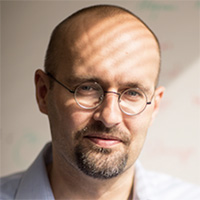By Jasmin Imran Alsous and Jörn Dunkel
Whether it is the arrangement of stacked oranges and whiskey caskets or the assembly of colloidal microclusters, the question at hand is one of packing. Packing problems are inescapable, encountered by all, and have long been studied by mathematicians and physicists. Until recently, Johannes Kepler’s 17th CE conjecture on the most efficient packing of spheres was one of geometry’s longest-enduring open questions. An interesting extension of such simple packing problems concerns the storage of connected objects in tight spaces, like a string of beads in a jewelry box. Far from being contrived, problems of this type arise in a variety of biologically-relevant contexts, from the packing of chromosomes in a cell’s nucleus to protein folding and synthetic assembly of multicellular aggregates.
A particularly compelling example occurs in the early steps of the development of sperm and eggs, which—from insects to mammals—originate in multicellular clusters. In contrast to most tissues, such clusters emerge from incomplete cell divisions that leave the two daughter cells physically connected by an intercellular bridge. These evolutionarily conserved bridges are large enough to facilitate intercellular transport and communication, a key step in the evolution of complex multicellular life forms. Since discovering them over a century ago, researchers have learned much about intercellular bridges’ molecular composition. Yet there are still many unknowns regarding the physical constraints that such intercellular connections impose on cell positioning and tissue organization. Indeed, an organism’s cells must be in the right place for the organism to develop properly; cell fate and position are intimately related. A prime example is the early 32-cell mouse embryo, in which cells are thought to “sense” their position and differentiate into one of two distinct lineages accordingly. Organismal development requires that cells acquire the correct identity, as the two resulting cell populations form the basis from which the various tissues are generated to support embryonic life.
A key challenge in furthering our understanding of the way in which topological and geometric constraints direct cell and tissue organization is the lack of accessible experimental systems that allow each cell and all of its neighbors to be tracked with precision in their natural setting. The fruit fly is a flagship model organism for understanding fundamental biological processes, from heart morphogenesis to axis specification in the embryo. We found that egg development in fruit flies offers a powerful system for generating an empirical and theoretical understanding of how topological and geometric constraints affect the packing arrangements of physically connected cells.
Egg development is a highly robust process that produces a normal egg capable of supporting a normal embryo’s growth. In fruit flies, an egg develops in a cluster with exactly 16 cells enveloped by an epithelial sheet so that each cell contacts this convex enclosure (see Figure 1a). One of the 16 cells is the oocyte and will become the future egg; the other 15 are called nurse cells, which—true to their name—nurse the egg by producing and transporting the biomolecules necessary for the egg and future embryo’s survival. The 16-cell cluster arises from four incomplete divisions of a founder cell that preserve the cells’ division history, thereby forming a cell lineage tree in which the cells and intercellular bridges define the nodes and edges respectively (see Figure 1b). This unique network topology and the highly stereotypic intercellular connections allow us to unambiguously identify each cell and its neighbors. More generally, they collectively present an opportunity to investigate a strangely neglected class of geometrically constrained tree packing problems. We thus asked the following question: How many ways can we embed 16 cells on convex polyhedra with 16 vertices? How is this lineage tree spatially embedded in three dimensions? As we showed in our work, published last July in Nature Physics, elucidating the manner in which linked structures are packed in confined enclosures requires solving a subgraph isomorphism problem.
Figure 1. 1a. A three-dimensional image of an ovarian cluster comprising 16 cells (gray) connected via intercellular bridges (red) and enveloped by an epithelium. 1b. The cluster as a network of nodes (cells) and edges (intercellular bridges), where each cell is uniquely identifiable. 1c. A surface reconstruction of a 16-cell cluster depicting the cells’ layered arrangement. 1d. A Johnson solid with 16 vertices showing one embedding of the cell lineage tree on an equilateral convex polyhedron.
Using single-cell imaging, computational image analysis, and three-dimensional reconstructions of fluorescently-labeled clusters (see Figure 1c), we observed that while cells are found in a layered arrangement dictated by their distance from the oocyte on the lineage tree, their position within any given layer varies. In fact, by reducing the problem’s dimensionality and considering how the three-dimensional packing of the cell tree unfolds in two dimensions, we found 72 unique planar embeddings exist for the 16-vertex tree (if we distinguish mirror symmetric configurations, the total number doubles to 144). Interestingly, our experimental data indicated that certain tree configurations were realized significantly more often than others.
To rationalize our experimental findings, we mapped the observed configurations onto a problem in graph theory. We first wanted to see if a very simple model—one that stripped away all real-world complexities and considered only geometrically-possible arrangements—could successfully explain our data. Remarkably, we found that certain tree configurations can be mapped onto a particular equilateral polyhedron with 16 vertices, the J90 Johnson solid, in more ways than others (see Figure 1d). Thermodynamically, this means that some cell-tree macrostates are realizable by a greater number of microstates and—akin to protein folding—entropic constraints favor particular cell-packing configurations over others. These arrangements are thus more commonly observed.
This simple model was purely geometric; though it captured the role of entropic effects, it neglected interactions between cells and their enclosure as well as cell-size effects. We hence considered a slightly more detailed energy-based model that generalized the famous Thompson problem of arranging particles with electrostatic Coulomb repulsions on spherical surfaces by allowing for rigid links between certain particles. We found that this energy-based approach reproduces many qualitative characteristics of the polyhedral model. However, when accounting for the problem’s biological aspects (namely the cells’ unequal sizes), this theoretical model also captured the cells’ highly conserved layered structure. We therefore believe that simple geometrical and physical effects can explain much of this complex biological system’s behavior.
While we focused on 16-cell ovarian clusters in the fruit fly, the underlying mathematical models are readily generalizable to arbitrary vertex numbers and a variety of developmental contexts. Our experimental and theoretical results thus provide a basis for understanding the principles that govern cells’ positional ordering in linked structures. By combining well-established ideas in mathematics with longstanding problems in biology, this work forges new connections between the two fields that are increasingly necessary to address fundamental and multiscale biological questions.
Further Reading
Imran Alsous, J., Villoutreix, P., Stoop, N., Shvartsman, S.Y., & Dunkel, J. (2018). Entropic effects in cell lineage tree packings. Nat. Phys., 14, 1016-1021.
 |
Jasmin Imran Alsous is currently a postdoctoral researcher in the Martin Lab at the Massachusetts Institute of Technology. She worked on this problem as a graduate student in the Shvartsman Lab in Princeton University’s Department of Chemical and Biological Engineering. |
 |
Jörn Dunkel is an associate professor in the Department of Mathematics at the Massachusetts Institute of Technology. |